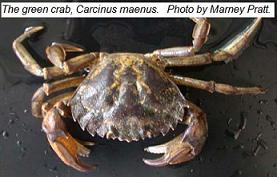Non-native species are organisms that have been transported via human activities and introduced to locations in which they previously did not occur. Environmental conditions have allowed them to successfully establish populations and reproduce. Examples in the Gulf of Maine include periwinkles and green crabs. When their presence and interactions with the new environment, habitat or species community are disruptive and have a negative impact, the introduction is termed "invasive."

Marine invasive species pose significant threats to Maine's marine and estuarine ecosystems and species of commercial importance such as soft-shell clams. Maine's most destructive and costly invader has been the green crab which arrived in the eastern U.S. in the mid-1800s via ballast water from vessels from Europe and significantly diminished the soft-shell clam resource. A more recent introduction, MSX (oyster disease) in 2010 in the Damariscotta River, threatens the center of Maine's oyster aquaculture industry.
Marine invasives are easily spread by ocean currents as well as by human activities such as shipping (ballast water) and transport by hull fouling on boats moving up and down the coast and across the seas. Our most effective means of dealing with marine invasive species is through prevention efforts, such as limiting importation and requiring inspections of imported species, fish health regulations, monitoring, and education.
Maine DMR monitors invasives through various surveys including our urchin dive survey, the Maine/New Hampshire Trawl Survey, and the scallop survey. The Department is also working closely with industry, academe, and with municipal shellfish programs to monitor green crabs. In addition, DMR regulates the importation of live marine organisms into state waters and the transfer of organisms between waterbodies, as well as the sale of lobster or crab bait to minimize the entry of disease, parasites or other organisms that may be dangerous to marine life.
Maine DMR is monitoring a number of marine invasive species that have been identified in recent years, including the green crab, Asian shore crab, Didemnum, which is a tunicate described as looking like pancake batter that spreads over the bottom and structures, and Codium, a spongy green algae that can completely cover and smother shellfish beds.
For information on invasive species mitigation and reporting: